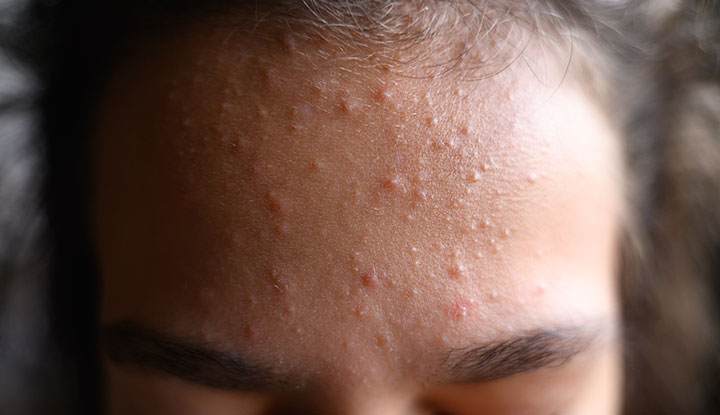Comedonal acne is a breakout of blemishes called comedones. Comedones are small bumps that appear when pores or hair follicles clog up with sebum and dead skin cells. Proper skin care, topical products, prescription medications and procedures can help treat comedonal acne.
Advertisement
Cleveland Clinic is a non-profit academic medical center. Advertising on our site helps support our mission. We do not endorse non-Cleveland Clinic products or services. Policy

Comedonal acne looks like many small bumps on your skin — often on your face — that aren’t inflamed. The bumps are pores or follicles that are clogged with sebum (an oily substance) and skin cells.
Advertisement
Cleveland Clinic is a non-profit academic medical center. Advertising on our site helps support our mission. We do not endorse non-Cleveland Clinic products or services. Policy
This type of acne is different from pimples, or inflammatory acne. Pimples are discolored (red, purple, brown, black) — usually darker than your normal skin tone — and filled with pus. Comedonal acne bumps are mostly the same color as the surrounding skin and not tender or swollen.
Comedonal acne (pronounced “KO-meh-DOH-nul” “AK-nee”) is very common. It most often affects preteens and teenagers. But many adults have it as well. It can occur in combination with other types of acne, like inflammatory papules and pustules.
There are two types of comedones:
Signs of comedonal acne on your skin include:
Advertisement
This type of acne usually appears on your forehead and chin. But it can affect other areas, like your nose, cheeks and back.
Comedones form when pores or hair follicles become clogged with dead skin cells and sebum. Sebum is a natural oily substance your pores release.
This can happen if you have:
Several factors may increase your risk of developing comedonal acne, like:
Without treatment, comedonal acne can turn into inflammatory acne. This type of acne can be painful. It may also be more noticeable.
Comedonal acne can also affect your self-esteem and mental health. Reach out to a healthcare provider if acne is making you feel negatively about yourself. Your mental health matters as much as your physical health.
A healthcare provider can diagnose comedonal acne by looking at your skin. You can visit your primary care physician or a dermatologist (skin specialist) for diagnosis.
Comedonal acne is typically the mildest form of acne. But it can be difficult to treat because the comedones are “stuck” within the follicles.
Several medical treatments can reduce the number and size of comedones. A healthcare provider can help you find the best treatment plan for your situation.
Products you put on your skin to treat comedonal acne include:
If comedonal acne doesn’t respond to topical treatments, your healthcare provider may prescribe oral medicines. They may include:
Your provider may recommend certain procedures to remove the clogging material from your skin, like:
Advertisement
Make sure to see a licensed professional for these procedures. Try not to pick, squeeze or pop comedones. Only a professional should do extractions. Doing it yourself can lead to:
With proper and persistent skin care and treatment, you may start to notice a difference in eight to 12 weeks. But it may take many months for comedonal acne to clear up.
See your healthcare provider if your treatment plan isn’t giving you the results you want. It can take time — and many tries — to find the right treatment and skin care routine.
If you get side effects from the medications, let your provider know.
Comedonal acne can be a long-term condition that comes back repeatedly over many years. Things you can’t control — like hormone fluctuations and genetics — play a strong role in it. But taking care of your skin can help minimize future breakouts:
Advertisement
Comedonal acne can be frustrating. But with the right treatment and skin care, it’s manageable. If you’re struggling to see results or feel overwhelmed, talk to a dermatologist. Together, you can find a plan that works for your skin — and your life.
Advertisement
Every day, people see your skin, hair and nails. At Cleveland Clinic, our expert and caring dermatology team will make sure they’re healthy and strong.

Last reviewed on 11/10/2025.
Learn more about the Health Library and our editorial process.